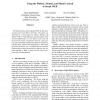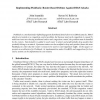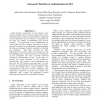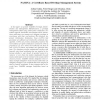NDSS
2002
IEEE
14 years 4 months ago
2002
IEEE
There have been a number of protocols proposed for anonymous network communication. In this paper we investigate attacks by corrupt group members that degrade the anonymity of eac...
NDSS
2002
IEEE
14 years 4 months ago
2002
IEEE
We implemented an attack against WEP, the link-layer security protocol for 802.11 networks. The attack was described in a recent paper by Fluhrer, Mantin, and Shamir. With our imp...
NDSS
2002
IEEE
14 years 4 months ago
2002
IEEE
Pushback is a mechanism for defending against distributed denial-of-service (DDoS) attacks. DDoS attacks are treated as a congestion-control problem, but because most such congest...
NDSS
2002
IEEE
14 years 4 months ago
2002
IEEE
Steganography is used to hide the occurrence of communication. Recent suggestions in US newspapers indicate that terrorists use steganography to communicate in secret with their a...
NDSS
2002
IEEE
14 years 4 months ago
2002
IEEE
Many business transactions on the Internet occur between strangers, that is, between entities with no prior relationship and no common security domain. Traditional security approa...
NDSS
2002
IEEE
14 years 4 months ago
2002
IEEE
In this paper we present PAMINA (Privilege Administration and Management INfrAstructure), a privilege management system using authorization certificates. Our system supports distr...
NDSS
2002
IEEE
14 years 4 months ago
2002
IEEE
This paper explores practical and conceptual implications of using Server-Aided Signatures (SAS). SAS is a signature method that relies on partially-trusted servers for generating...
NDSS
2002
IEEE
14 years 4 months ago
2002
IEEE
TLS is the protocol of choice for securing today’s ecommerce and online transactions, but adding TLS to a web server imposes a significant overhead relative to an insecure web ...
NDSS
2002
IEEE
14 years 4 months ago
2002
IEEE
NDSS
2002
IEEE
14 years 4 months ago
2002
IEEE
In this paper we address the problem of secure communication and authentication in ad-hoc wireless networks. This is a difficult problem, as it involves bootstrapping trust betwe...





